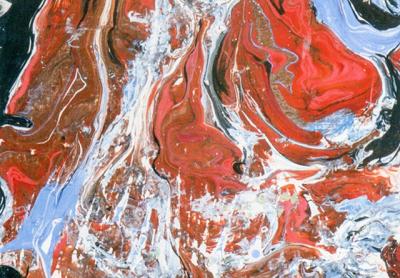Abstract Expressionism Behind the Iron Curtain

Although many treat “Abstract Expressionism” as a uniquely American phenomenon, its emotional bravura approach to art-making did inspire artists in Europe to participate in a free exchange of ideas, resulting in their own Art Informel movement.
There were others though, who were not so free to express themselves or who did not have direct access to these ideas. Yet somehow these artists too, in Soviet Bloc countries during the 1950s and 1960s, managed to discover what their colleagues were doing elsewhere and began reacting to it.
The results of these efforts are included in a small but powerful exhibition at the Pollock-Krasner House and Study Center in Springs, featuring artists from Eastern Europe who bucked the conventions and limitations imposed by their Communist leaders.
Andrej Jemec from Slovenia, Tadeusz Kantor from Poland, Jan Kotik from the former Czechoslovakia, Edo Murtic from Croatia, and Romul Nutiu from Romania were notable not just in their success in seeking out developments in art that were being deliberately withheld from them, but in remaining in their countries and making art under their own terms.
Kantor, one of the most visionary of painters in the room, was also the most well traveled. He was a painter and theater director who let both aspects of his creative life interact on the canvas, and his 1958 “Composition” is an apocalyptic explosion of drips and clouds of light and dark paint. It’s hard not to see figures or faces in the abstract soup, perhaps a holdover from his earlier style from the 1940s, where tangled and deformed figures made up the compositions. This particular work, created well after the war, still seems haunted by it.
Kantor moved on at a point when others also had fled action painting, incorporating found objects into his compositions. In “Chelsea,” a shopping bag has been mounted to the canvas and bathed in layers of black paint so that it is almost unrecognizable. A cluster of circular blobs of color accompany it. He sought out “reality of the lowest rank,” says the show’s catalog, to ennoble in his paintings, including umbrellas, rags, and crumpled paper, following in the path of Neo-Dadaists such as Robert Rauschenberg.
Jemec, who is represented by two relatively large canvases from 1960, uses black bands of paint to carve up his grayish and white ground. In the painting “In the Forest,” it seems as if the day or night sky is concealed by a skeletal canopy. “Battle” also features what could be a sky obscured, this time possibly by planes and explosions, hinted at by the touches of red and yellow in the mix and what could be a plume of smoke. It is difficult not to see the psychological impacts of the Cold War and its threat of mutually assured destruction in the artwork.
Kotik was a Czech who spent his later years in Sweden and West Berlin. His work on view is from his gestural abstraction period after 1948. “Calligraphy (Black Painting),” from 1961, is a collection of white lines of various thicknesses, accumulated in a rounded figure with lines descending beneath it. It is vaguely reminiscent of a fish or other sea creature, or even a mushroom cloud, spindly and tinged with menace. His “Painting 22” is an assemblage of uneven orbs in different hues. In the spaces in between are brush marks and groups of lines in a very flat presentation.
The geometric abstractions of Murtic are reminiscent of Adolph Gottlieb in one and Kasimir Malevich in another. They were known in what was then Yugoslavia as “Socialist Modernism.” The country differed from others in Eastern Europe in that it was able to break ties with Stalin’s U.S.S.R. in 1948, which allowed a more permissive government and cultural environment. Murtic was in this country from 1951 to 1952 and met such local celebrities from the New York School of painting as Jackson Pollock, Willem de Kooning, and James Brooks. His art was shown in a traveling exhibition of Yugoslavian art that went to Manhattan, Boston, and Washington, D.C.
A Romanian, Nutiu was a late arrival to the world of action painting, but his works on view, painted in 1966 and 1970, are strong examples of the genre. He developed his compositions in troughs of water, into which he poured oil paint. As the colors bled on the surface, he played with them with a stick, blending them into compositions. When they were to his liking he placed a canvas on the surface to absorb the paint. The resulting works have very fluid elements, some that look like bubbles, or basic cellular creatures, or just an overall blending of forms and linear marks that feel at a remove from the artist’s hand.
The works at Pollock-Krasner come from a broad base of international institutions and collections, which include Moderna galerija in Ljubljana; the Muzeum Sztuki, in Lodz; the Muzej Suvremene Umjetnosti in Zagreb, and the Fundatia Joana Grevers in Munich.
The exhibition will remain on view through Oct. 28.
